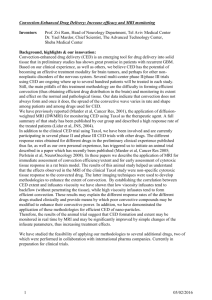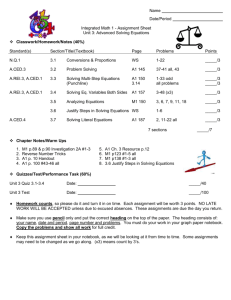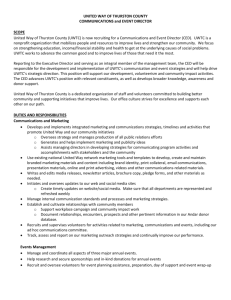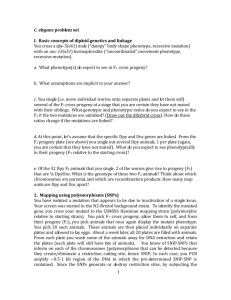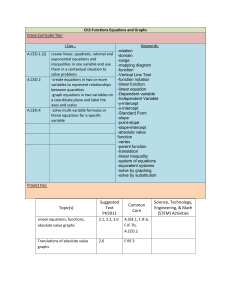Chrom. I (test snp at +0.08)
advertisement
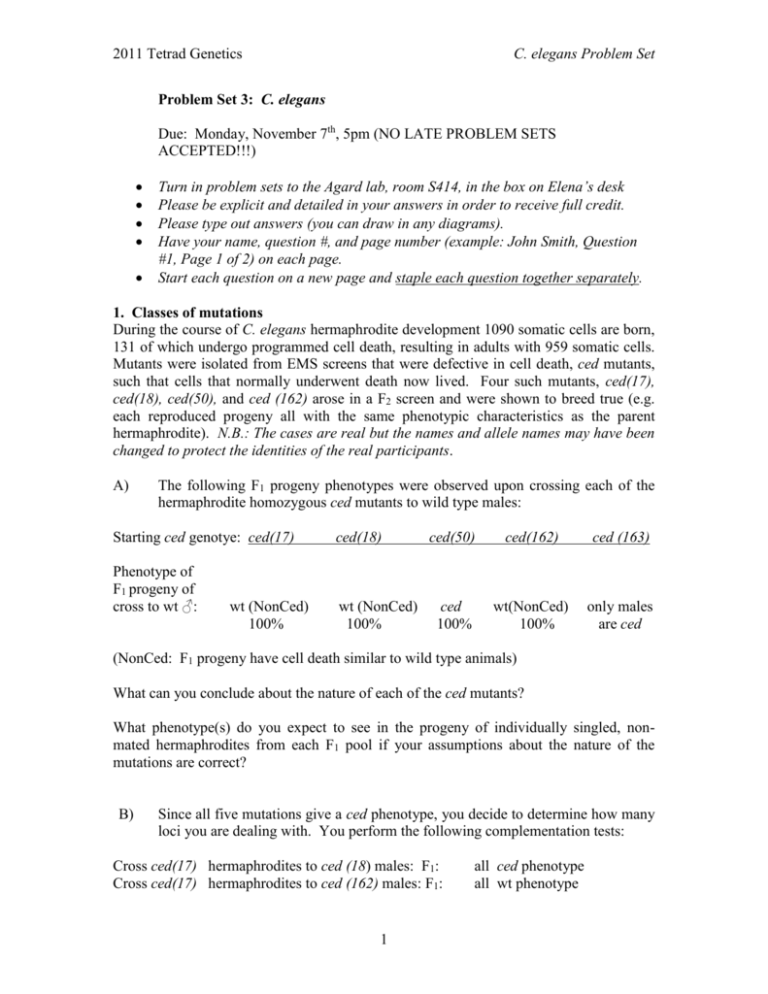
2011 Tetrad Genetics C. elegans Problem Set Problem Set 3: C. elegans Due: Monday, November 7th, 5pm (NO LATE PROBLEM SETS ACCEPTED!!!) Turn in problem sets to the Agard lab, room S414, in the box on Elena’s desk Please be explicit and detailed in your answers in order to receive full credit. Please type out answers (you can draw in any diagrams). Have your name, question #, and page number (example: John Smith, Question #1, Page 1 of 2) on each page. Start each question on a new page and staple each question together separately. 1. Classes of mutations During the course of C. elegans hermaphrodite development 1090 somatic cells are born, 131 of which undergo programmed cell death, resulting in adults with 959 somatic cells. Mutants were isolated from EMS screens that were defective in cell death, ced mutants, such that cells that normally underwent death now lived. Four such mutants, ced(17), ced(18), ced(50), and ced (162) arose in a F2 screen and were shown to breed true (e.g. each reproduced progeny all with the same phenotypic characteristics as the parent hermaphrodite). N.B.: The cases are real but the names and allele names may have been changed to protect the identities of the real participants. A) The following F1 progeny phenotypes were observed upon crossing each of the hermaphrodite homozygous ced mutants to wild type males: Starting ced genotye: ced(17) Phenotype of F1 progeny of cross to wt ♂: wt (NonCed) 100% ced(18) wt (NonCed) 100% ced(50) ced(162) ced (163) ced 100% wt(NonCed) 100% only males are ced (NonCed: F1 progeny have cell death similar to wild type animals) What can you conclude about the nature of each of the ced mutants? What phenotype(s) do you expect to see in the progeny of individually singled, nonmated hermaphrodites from each F1 pool if your assumptions about the nature of the mutations are correct? B) Since all five mutations give a ced phenotype, you decide to determine how many loci you are dealing with. You perform the following complementation tests: Cross ced(17) hermaphrodites to ced (18) males: F1: Cross ced(17) hermaphrodites to ced (162) males: F1: 1 all ced phenotype all wt phenotype 2011 Tetrad Genetics C. elegans Problem Set Cross ced(17) hermaphrodites to ced (163) males: F1: Cross ced(162) hermaphrodites to ced(163) males: F1: all wt phenotype all wt phenotype What do you conclude about each of the mutations? What do you expect to see in terms of phenotypes in the F1 progeny of ced(17) males x ced(163) hermaphrodites? Why was ced(50) not included in the complementation tests? C) You have already characterized another cell death defective mutant, ced-9. The allele that you have is ced-9(10) which behaves as a dominant mutant and is not haploinsufficient (only having one wild type copy of ced-9 does not phenocopy the ced9(10) phenotype). Your lab-mate tells you that to really know whether ced-9 has anything to do with cell death, you need to analyze its null phenotype. Why is that? II. Epistasis analysis and pathway building: During programmed cell death cells are killed off and the corpses are engulfed and cleared by neighboring cells. Regulatory relationships between pathway components may be inferred through epistasis. Consider the following results for ced (cell death defective) mutants (cell counts refer to final tally in adult hermaphrodites excluding the germ-line): Genotype Wild type ced-3(lf) ced-4(lf) ced-9(lf) ced-9(lf); ced-3(lf) ced-9(lf); ced-4(lf) live cells 959 1090 1090 0 1090 1090 dead cells 131 0 0 1090 0 0 A) What regulatory relationships can be inferred between ced-3, ced-4, ced-9 and their relationship to cell death? Include a possible regulatory pathway and note any ambiguities. Corpse engulfment genes of programmed cell death are identified as mutations in which cell death still occurs leaving a visibly identifiable cell corpse but one that is not cleared away. Consider: Genotype ced-1(lf) ced-3(lf) phenotype cells die, but leave ugly corpses cells do not die 2 2011 Tetrad Genetics ced-1(lf), ced-3(lf) C. elegans Problem Set cells do not die B) What is the epistatic relationship of ced-3 and ced-1? (initial identification of engulfment mutants (e.g. ced-1) allowed for identification of “killer” genes such as ced-3 since they emerged, as you can see, as suppressors of the ced-1 phenotype). It is quite difficult to count cell deaths through the lineage (tracing all 131). In practice, one can focus on one anatomical area of the worm and focus on death events there and, if needed, show that findings in that region are also mimicked by phenotypes seen in other cell types/anatomical regions. For instance, loss of function mutations in ced-1, ced-2, ced-7, and ced-10 were identified as engulfment genes as null mutations in each of these genes left, on average, one corpse per pharynx (C. elegans feeding organ). However, more than one cell undergoes programmed cell death in the pharynx, implying that some corpse engulfment is still occurring in each of the single mutant backgrounds. The following results were obtained from mutant combinations (all cases are null alleles): ced-1; ced-2: average four corpses/pharynx ced-1; ced-7: average one corpse/pharynx ced-1. ced-10: average four corpses/pharynx ced-2; ced-7: average four corpses/pharynx ced-2; ced-10: average one corpse/pharynx ced-7; ced-10 average four corpses/pharynx C) What can you conclude about relationships between these four ced genes? III. Mapping— You have isolated a mutation that appears to be due to inactivation of a single locus. Your screen was started in a N2 background strain. To map your genes, you cross your mutant to the CB4856 Hawaiian mapping strain. You pick F1 cross progeny, allow them to self, and from their progeny you pick animals that display your mutant phenotype. You pick 20 such animals. These animals are then placed individually on separate plates, allowed to lay eggs. About a week later, all 20 plates are filled with animals. From each plate you wash some of the animals away for DNA extraction and retain the plates (each plate will still have lots of animals). Using SNIP-SNPs you test the extracted DNAs. Based on SNIP-SNP cutting patterns you can score each SNP as CB4856 (CB), N2, or both. To determine chromosomal linkage, you start testing the first 10 of your F2s. The SNIP-SNP patterns of N2 and CB for each chromosomal marker are shown. Chrom. I (test snp at +0.08) N2 CB 1 2 3 4 5 6 7 8 9 10 _ _ _ _ _ _ _ _ _ _ _ _ _ _ _ _ _ 3 2011 Tetrad Genetics C. elegans Problem Set Chrom II (test snp at +1.2) N2 CB 1 2 3 _ _ _ _ _ _ _ _ _ _ _ Chrom III (test snp at –0.9) N2 CB _ _ 1 _ _ 2 _ 4 _ _ _ 5 6 7 8 _ _ _ _ _ _ _ _ 4 _ 5 7 _ 8 _ 6 _ _ 4 5 6 7 _ _ _ _ _ _ _ 3 _ 4 _ 5 _ 6 _ 7 _ 3 _ _ _ 4 _ _ _ 5 6 _ _ _ 7 3 _ Chrom IV (test snp at -1.5) N2 CB 1 2 3 _ _ _ _ _ _ _ _ _ Chrom V (test snp at + 2.1) N2 _ CB 1 _ _ _ 2 _ _ _ Chrom X (test snp at +2.2) N2 CB 1 2 _ _ _ _ _ _ _ _ _ _ _ 9 _ 10 _ _ _ 9 _ 10 _ 9 _ _ _ 10 _ _ _ 8 _ _ _ 9 _ 10 _ 8 _ _ _ 9 _ 10 _ _ _ _ 8 _ _ _ _ a) Which chromosome does this mutation map to? b) What is a rough estimate of the map position of your mutation? Now, using SNPs along the chromosome containing your mutation, you then get the following data (The SNPs are shown in proper genetic order, ie. SNP1 is on the left arm and SNP5 is on the right arm). Remember double recombination events on one chromosome occur but are rare): Starting strain CB4856 1 2 3 SNP1 N2 SNP2 N2 SNP3 N2 SNP4 N2 SNP5 N2 CB/CB CB/CB CB/CB CB/CB CB/CB N2/N2 N2/N2 N2/CB N2/CB CB/CB N2/CB N2/N2 N2/CB N2/N2 N2/N2 N2/N2 N2/N2 N2/CB N2/CB N2/N2 4 2011 Tetrad Genetics 4 5 6 7 8 9 10 11 12 13 14 15 16 17 18 19 20 CB/CB CB/CB N2/N2 N2/CB N2/CB N2/CB N2/CB N2/N2 N2/CB N2/N2 N2/N2 N2/N2 CB/CB N2/CB N2/CB N2/CB N2/N2 C. elegans Problem Set N2/CB CB/CB N2/N2 N2/CB N2/CB N2/CB N2/CB N2/N2 N2/CB N2/N2 N2/N2 N2/N2 N2/CB N2/CB N2/CB N2/CB N2/N2 N2/N2 CB/CB N2/N2 N2/N2 N2/CB N2/CB N2/CB N2/N2 N2/CB N2/N2 N2/N2 N2/N2 N2/CB N2/N2 N2/CB N2/CB N2/N2 N2/N2 CB/CB N2/N2 N2/N2 N2/N2 N2/N2 N2/N2 N2/N2 N2/N2 N2/N2 N2/CB N2/N2 N2/N2 N2/N2 N2/N2 N2/N2 N2/N2 N2/N2 N2/CB N2/CB N2/N2 N2/CB N2/N2 N2/N2 N2/N2 N2/N2 CB/CB N2/CB N2/CB N2/N2 N2/N2 N2/N2 N2/N2 N2/CB c) Which marker is most closely linked to the mutation? d) Indicate the likely location of your mutation (between which markers?). e) What ambiguities still exist about the location of the mutation (what doesn’t fit with the rest of the data)? What can you do to address this? 5

